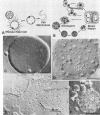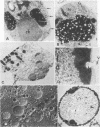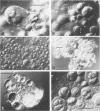Abstract
The history of B. hominis is unique. Few infectious agents have provoked the many misconceptions that plague this enigmatic parasitic ameba. Conflicting descriptions of its nature and pathogenesis have continued throughout the 20th century. As seen by the greatly expanded number of reports in recent years, B. hominis is now a major subject of study, particularly for evidence of disease causation. Physicians are treating patients with intestinal disease caused by B. hominis. Many mild cases resolve in about 3 days without treatment, but others are acute and chronic disease is common. As with E. histolytica, the carrier state is often seen without symptoms. Treatment is usually with metronidazole, but emetine (for refractory infections), trimethoprim-sulfamethoxazole, and pentamidine are also effective. In fecal samples, this complex protozoan appears in a variety of cell forms which makes microscopic diagnosis difficult. As yet, no specific fluorescent-antibody test is available for diagnosis. A culture method to demonstrate the more easily recognized CB form is available, but probably not feasible for most diagnostic laboratories. The common cell forms are the CB form, the granular (mitochondria) form, and the ameba form. The unexpected size range of these forms in clinical material, from yeast size (ca. 7 microns) to giant cells of 20 to 40 microns, makes diagnosis difficult Pseudopodia may be demonstrated by the ameba form in heated microscope stage culture chambers. The anaerobic B. hominis has no cyst form. Its mitochondria are uniquely anaerobic and have no cytochrome protein or oxidative mitochondrial enzymes. Because of its many cell forms and anaerobic mitochondria, B. hominis is an organism of great interest for morphologic and biochemical study. Reproduction is asexual, usually by binary fission. Shizogony occurs in cultured cells. The CB appears to be an organelle whose specific purpose is for reproduction by shizogony. From 2 to 30 progeny are derived from schizogony. The ameba form reproduces by plasmotomy; it has no CB. The pathology of B. hominis infections has been studied in gnotobiotic guinea pigs in which inflammation of the intestinal mucosa and invasion of the superficial layers were seen. Only limited studies of human pathology are available. Those who have studied mucosal histopathology report inflammation and cellular changes that resolve after treatment. More study in this area is strongly indicated (32, 44, 57, 62, 67, 75). Ultrastructural details of B. hominis major forms, except for the schizont, are complete. The organism has no cell wall. The concentric CB takes up as much as 95% of the cell. The major organelles, which include multiple nuclei, Golgi apparatus, mitochondria, endoplasmic reticulum, fat, and other inclusions, are confined in two or four opposed pods in a thin band of peripheral cytoplasm between the spherical entire plasma membrane and the CB membrane. The pods buldge the CB membrane inward. There is evidence of a bacteroid endosymbiont. Education about B. hominis is needed. Entry of recent findings into new textbooks is imperative for its understanding among medical practitioners. Laboratory workers need to be aware of it for many reasons. The College of American Pathologists includes B. hominis in its proficiency testing samples and requires that it be reported from clinical samples.
Full text
PDF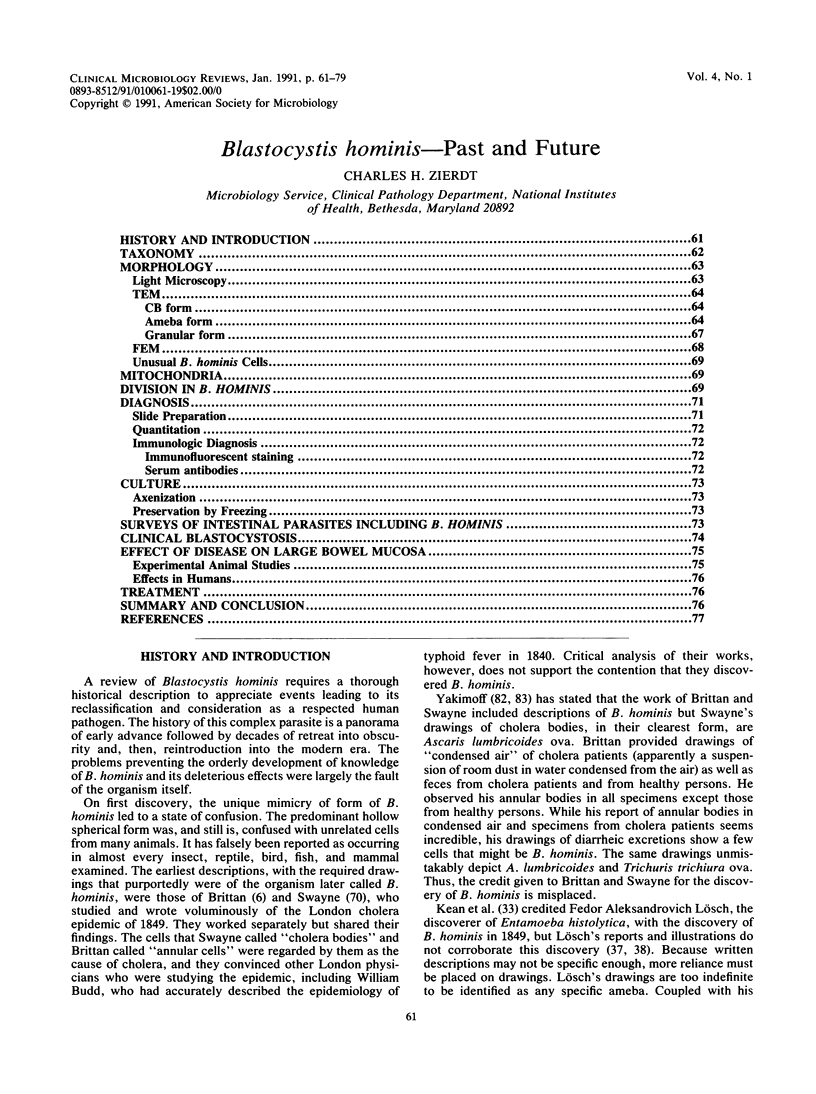
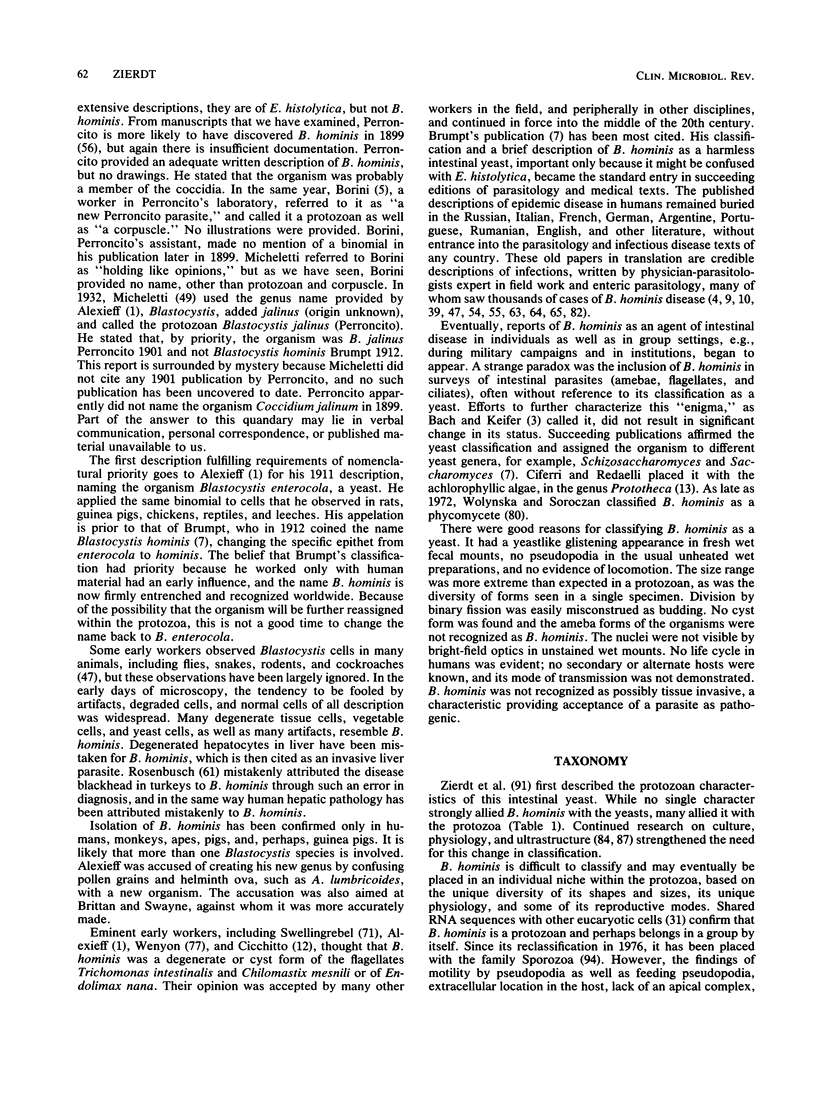
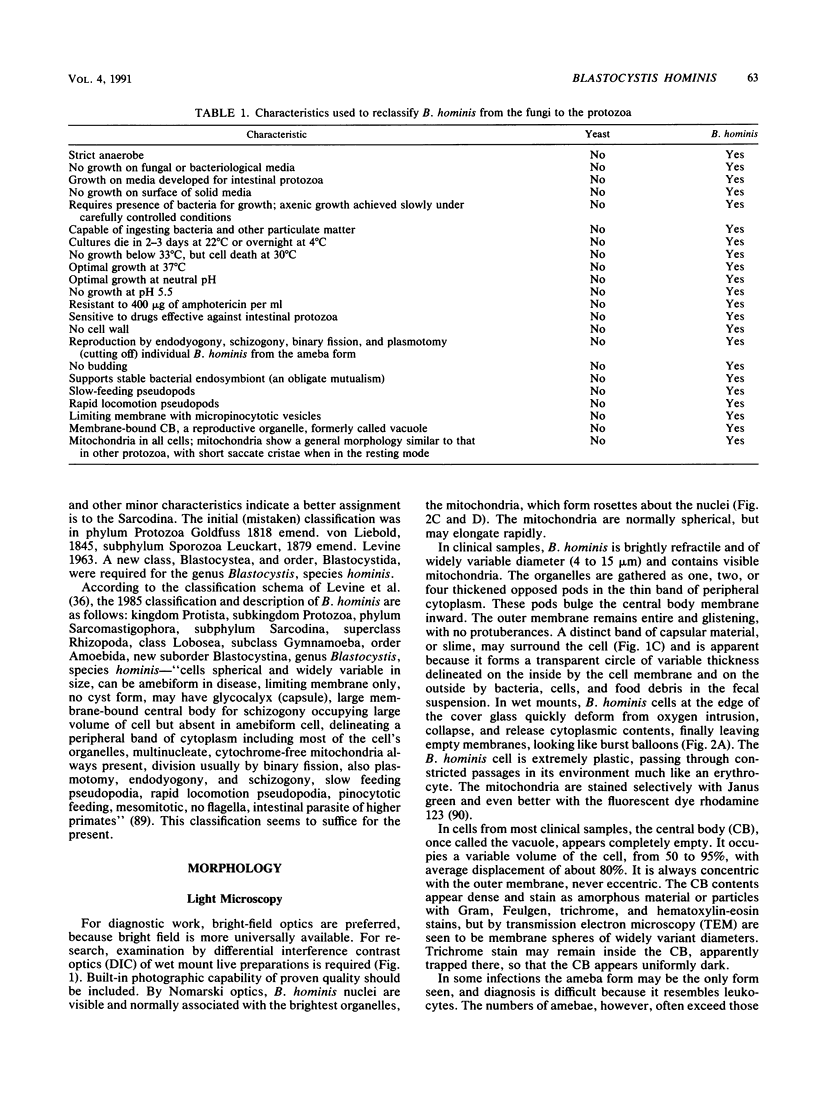
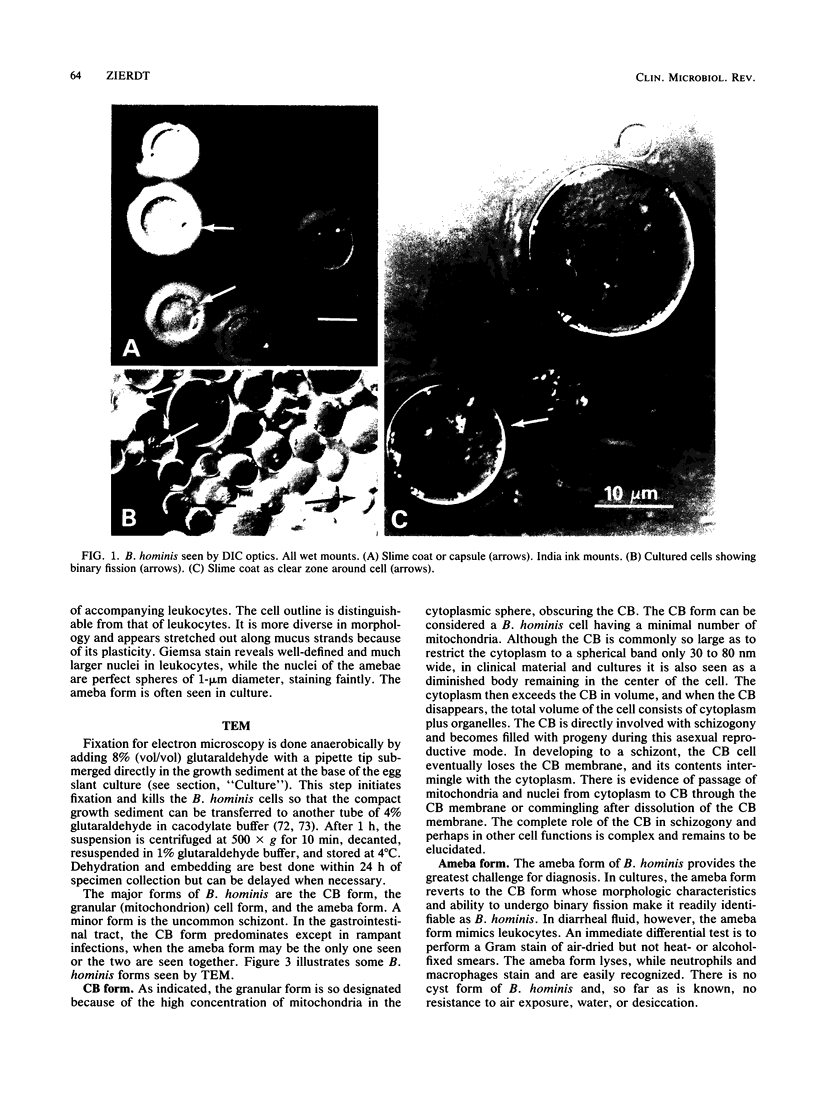
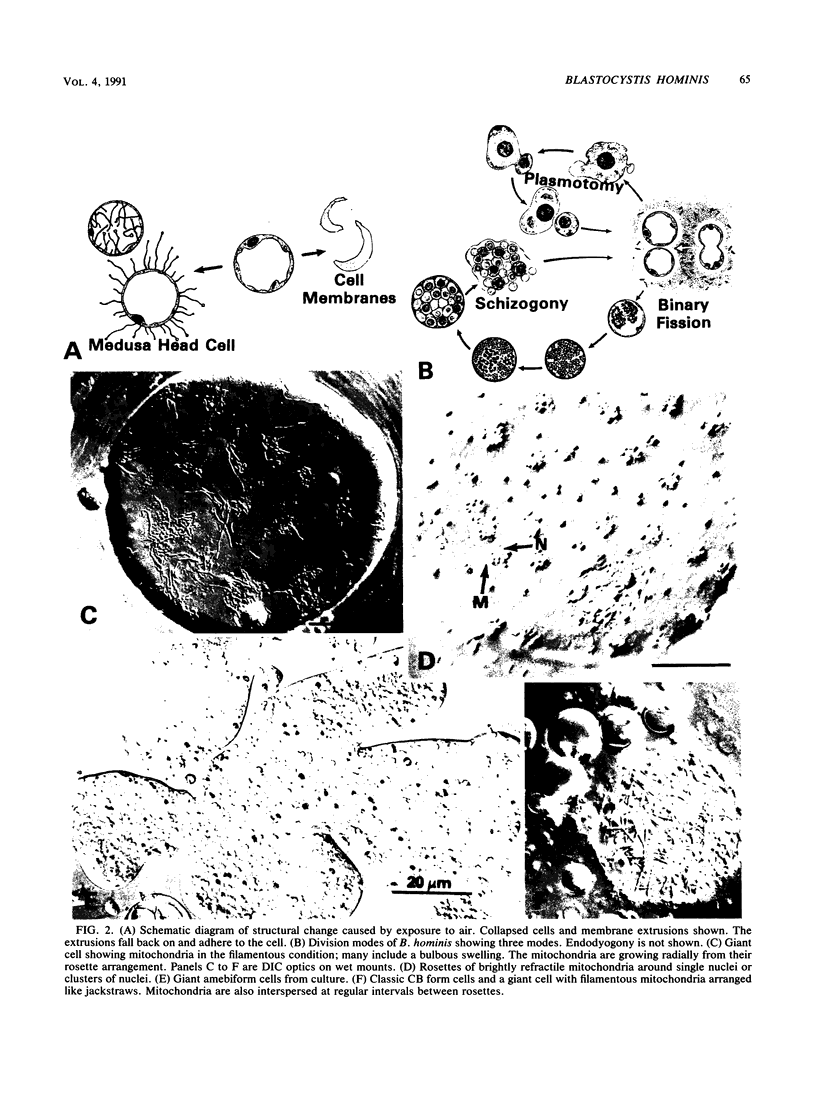
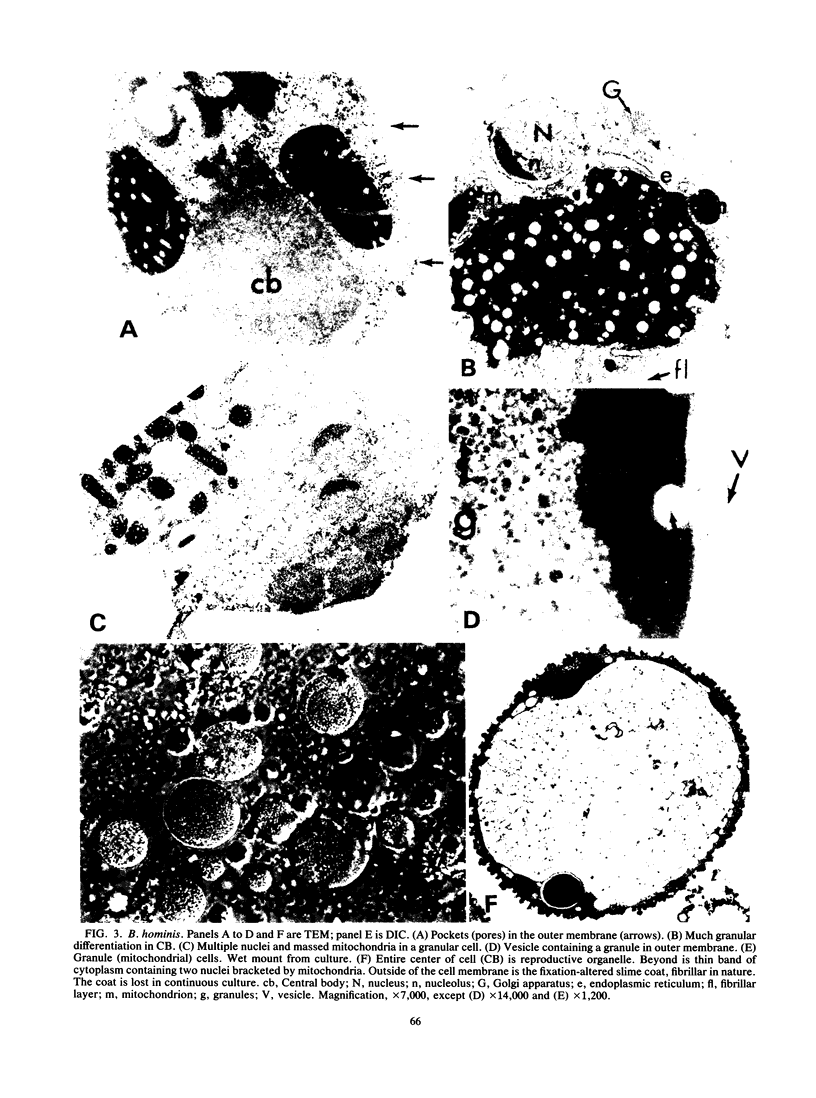
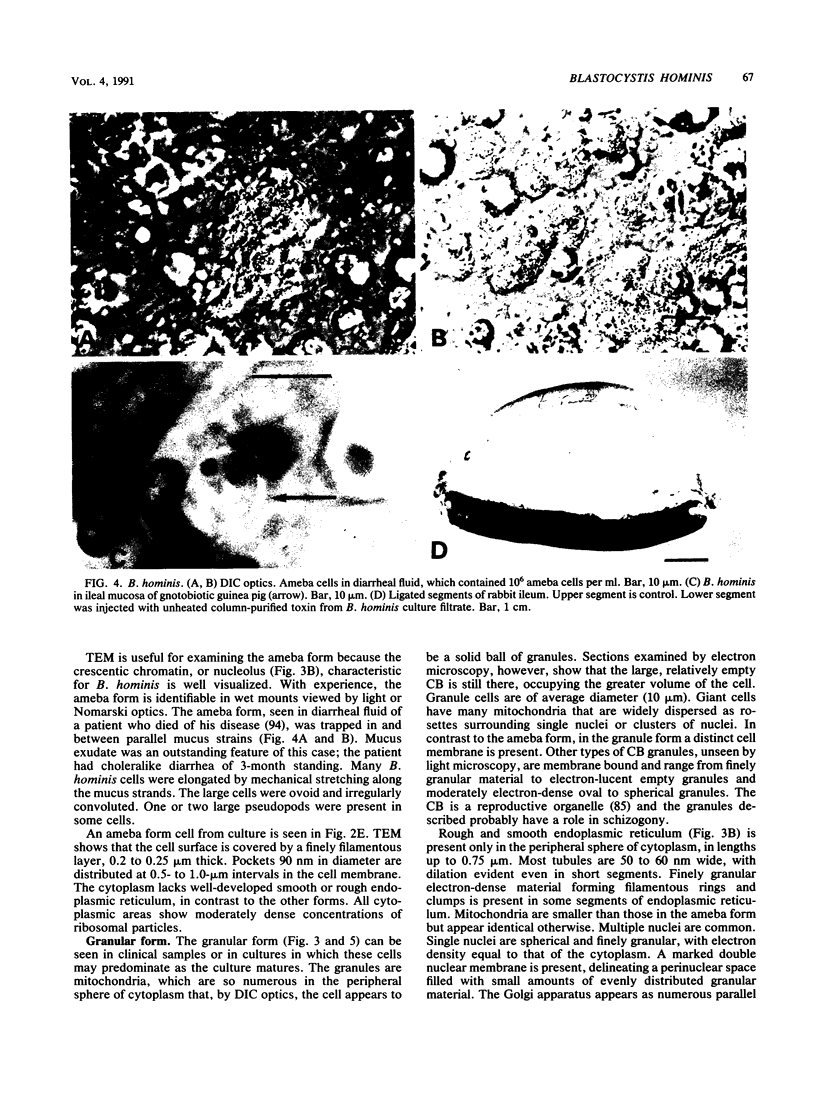
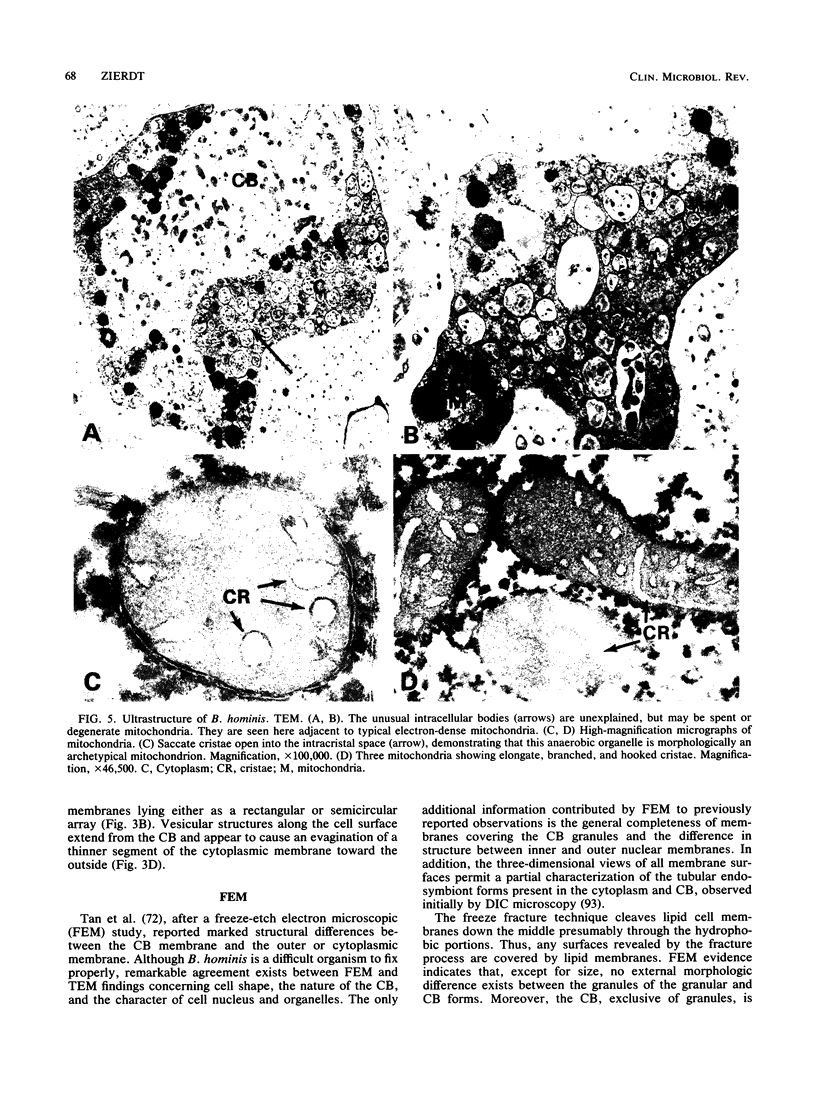
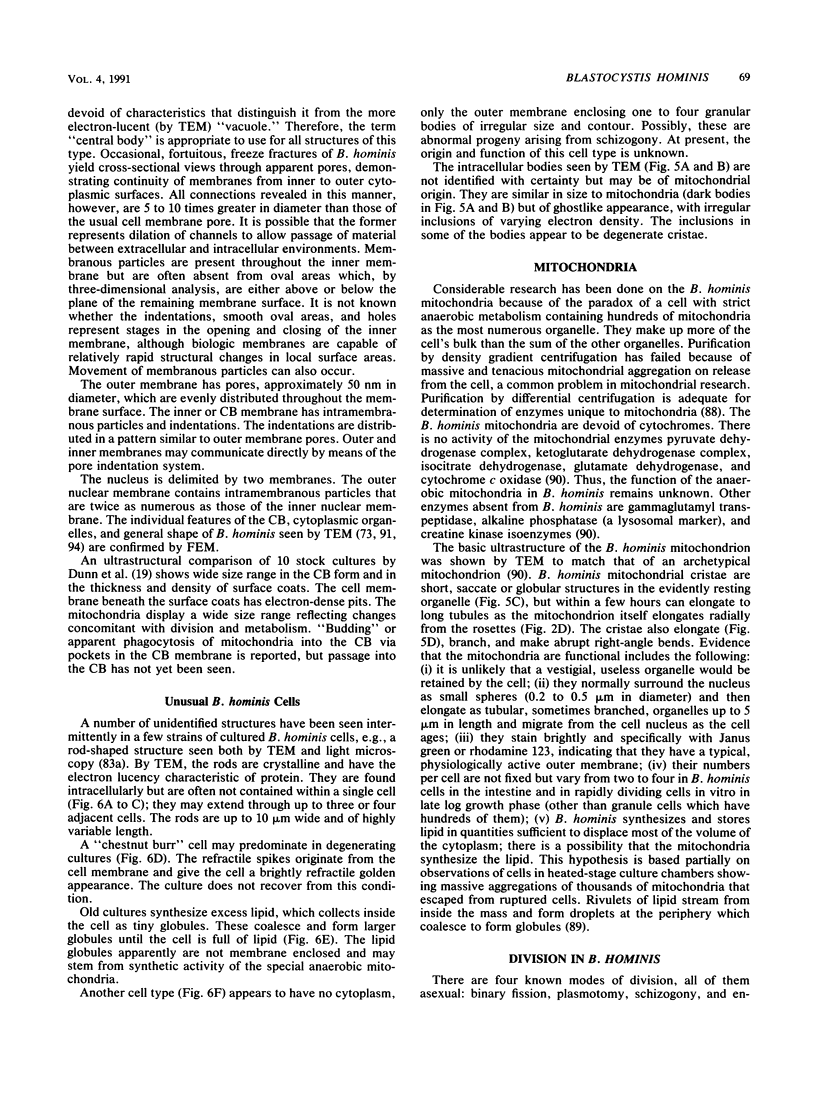
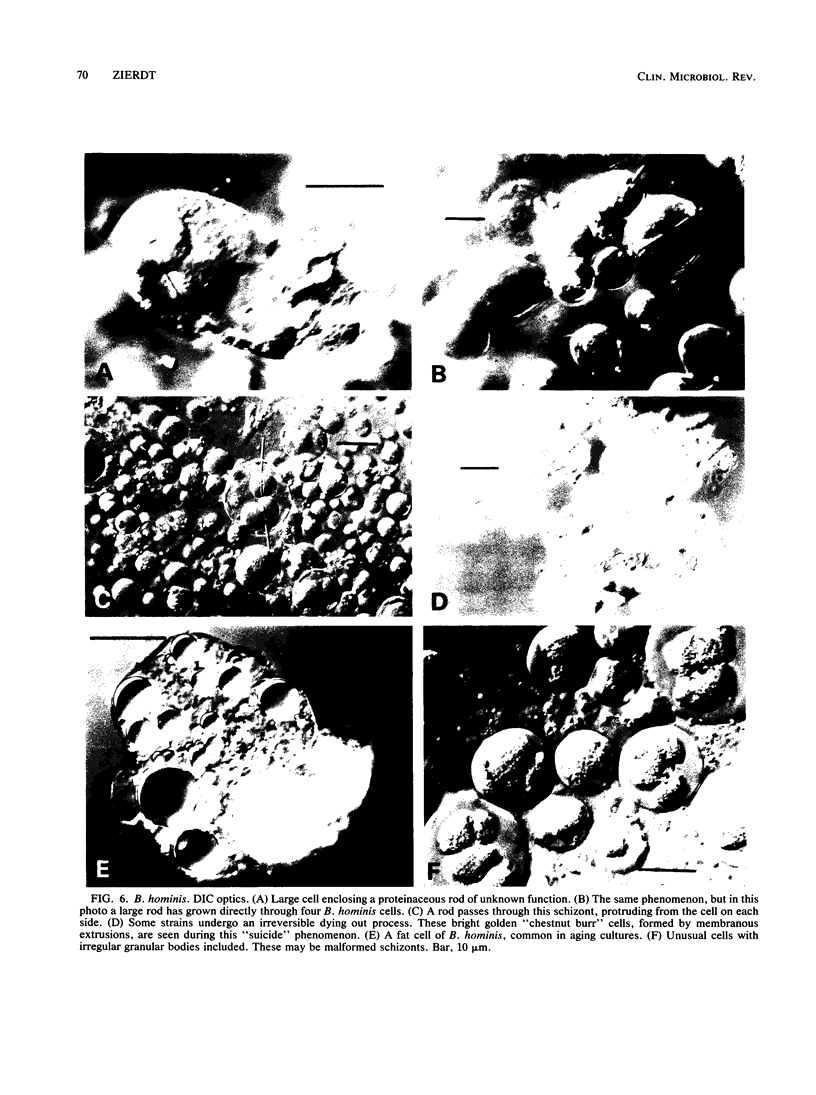
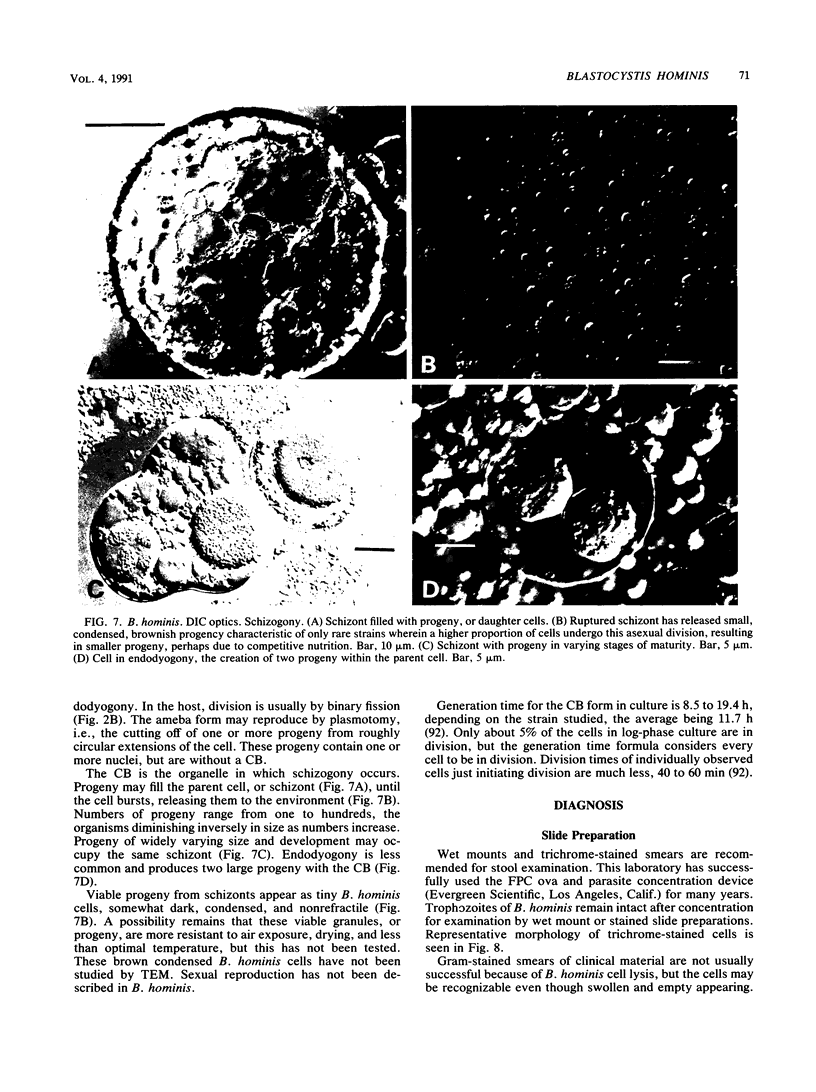
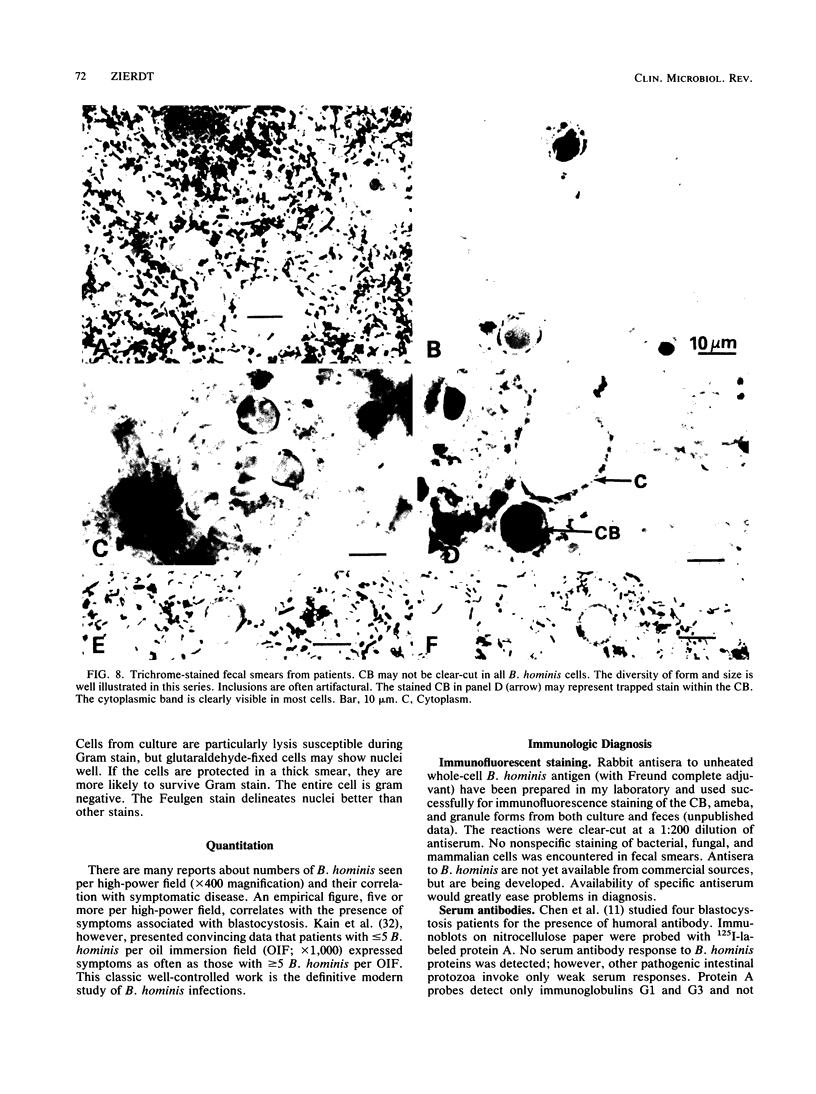
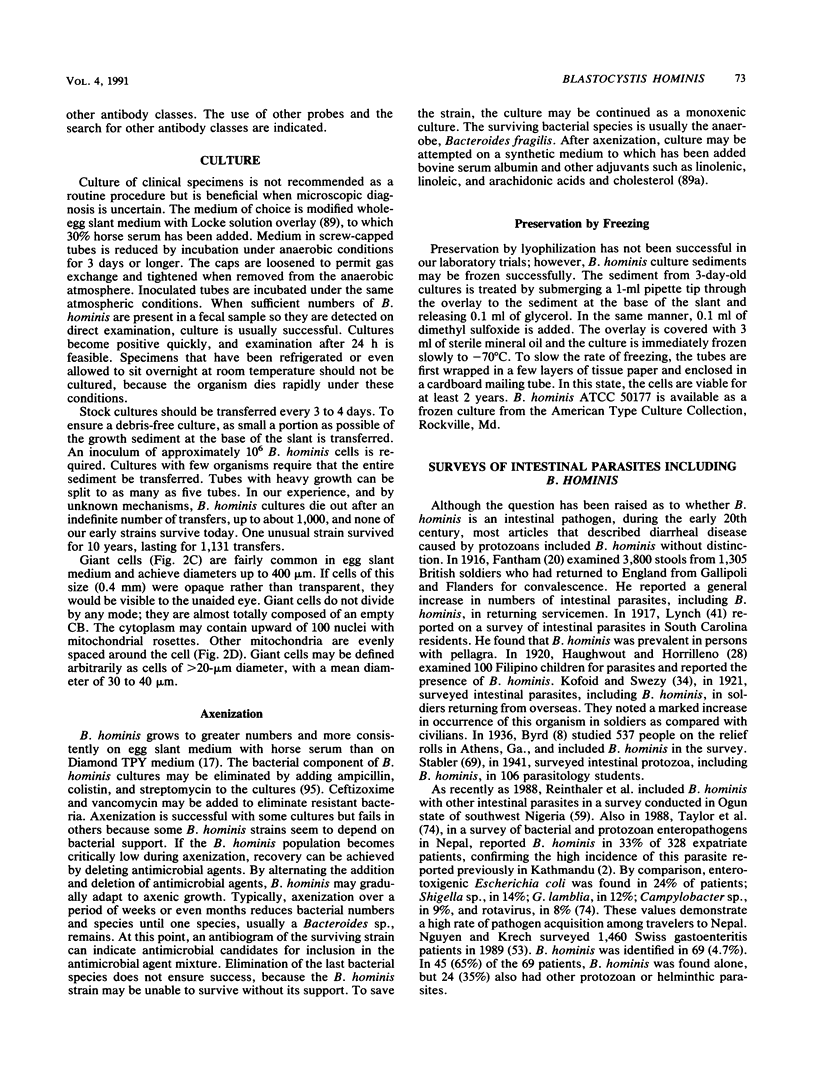
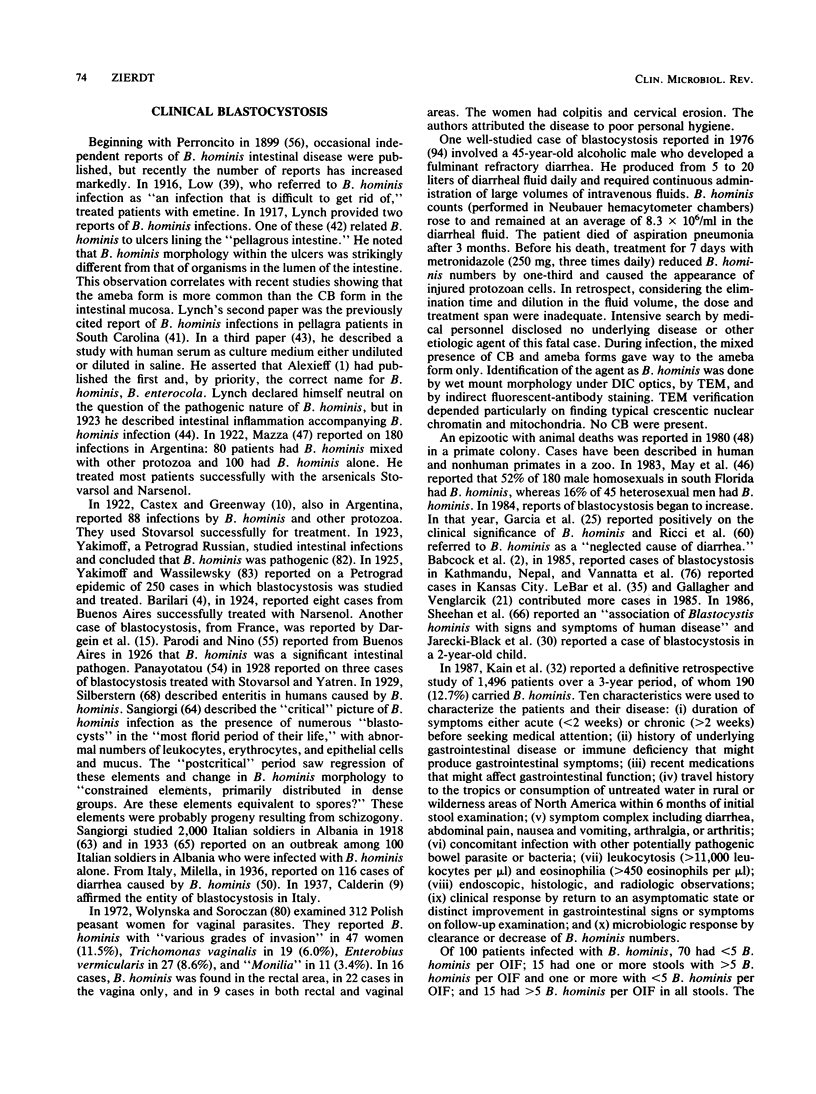
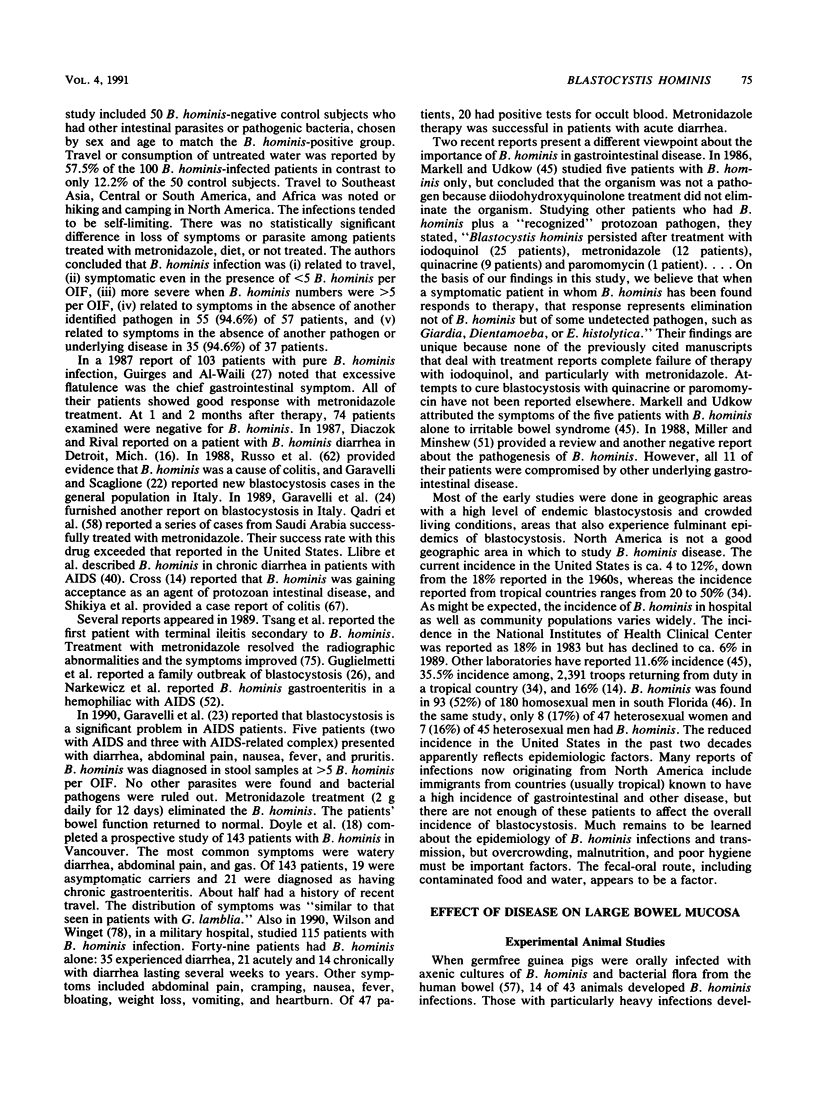
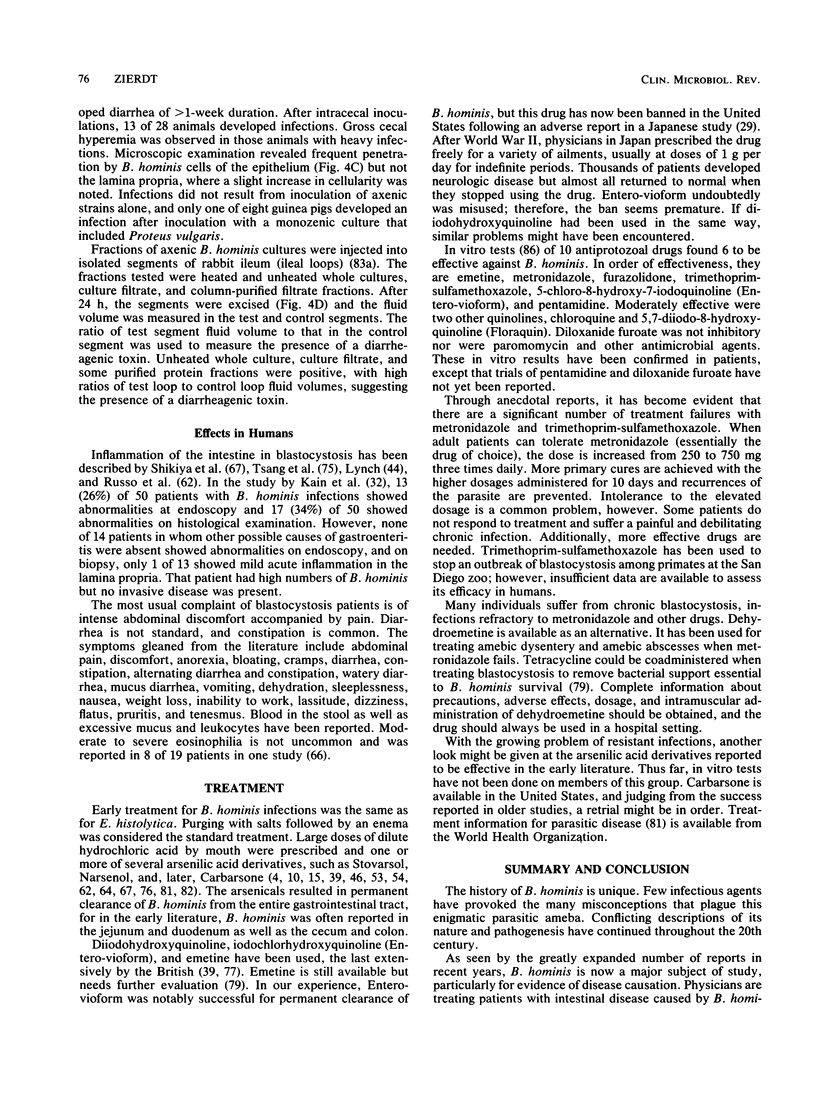
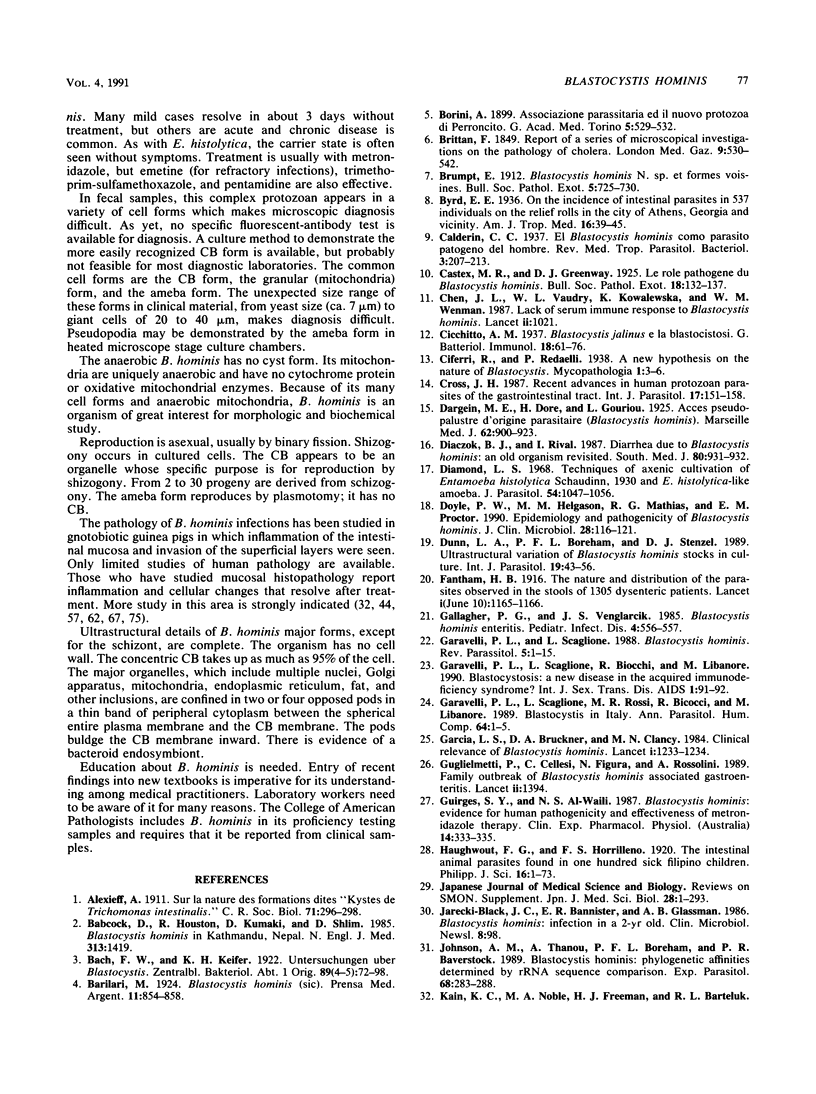
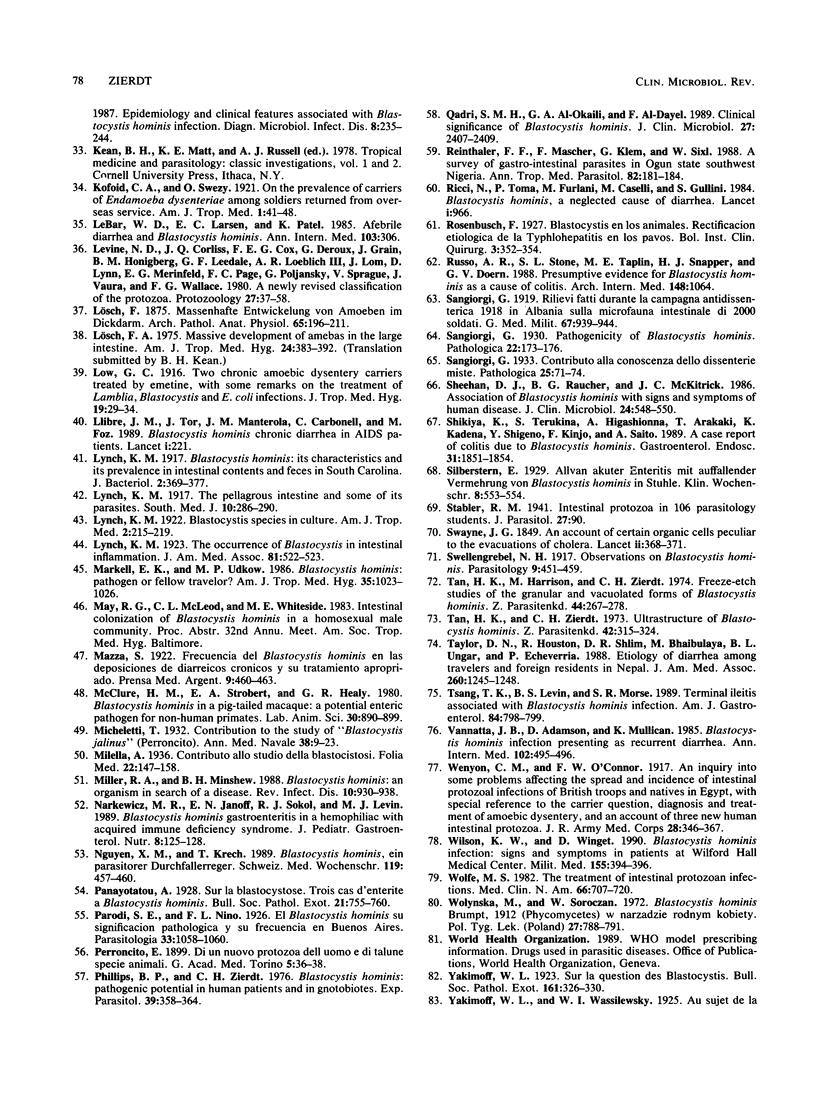
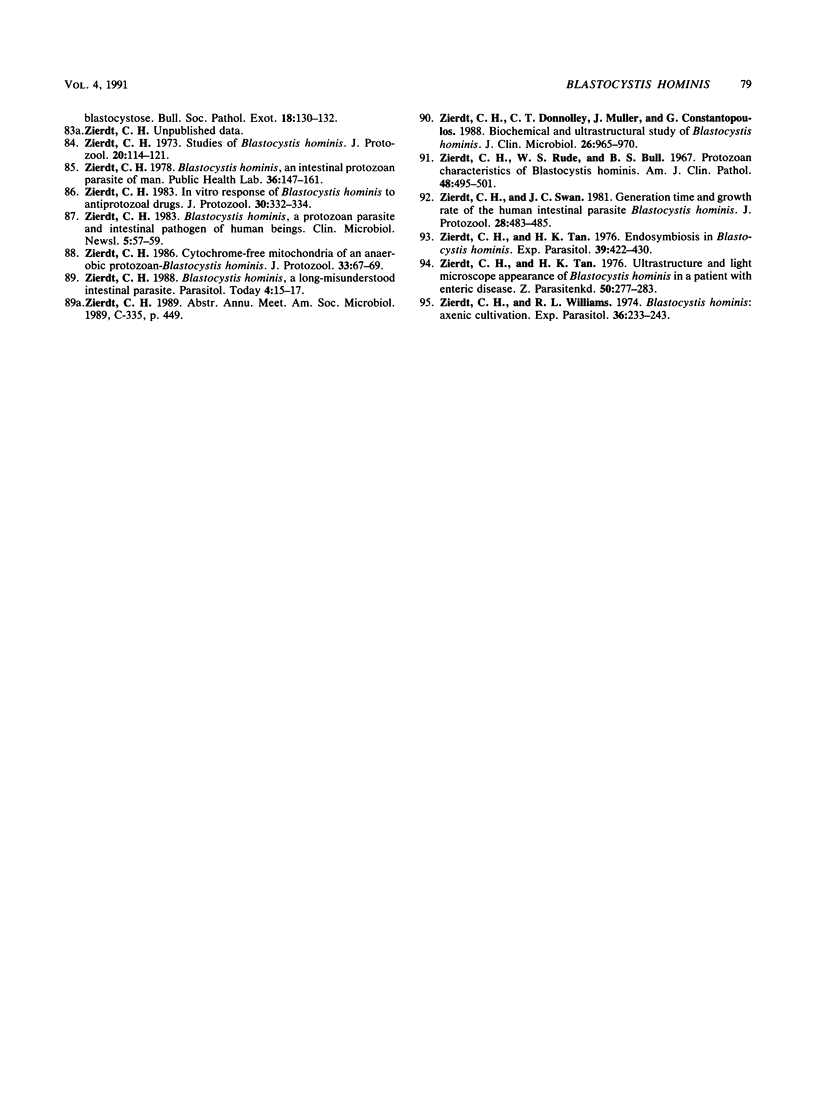
Images in this article
Selected References
These references are in PubMed. This may not be the complete list of references from this article.
- Babcock D., Houston R., Kumaki D., Shlim D. Blastocystis hominis in Kathmandu, Nepal. N Engl J Med. 1985 Nov 28;313(22):1419–1419. [PubMed] [Google Scholar]
- Chen J. L., Vaudry W. L., Kowalewska K., Wenman W. M. Lack of serum immune response to Blastocystis hominis. Lancet. 1987 Oct 31;2(8566):1021–1021. doi: 10.1016/s0140-6736(87)92580-3. [DOI] [PubMed] [Google Scholar]
- Clinical relevance of Blastocystis hominis. Lancet. 1984 Jun 2;1(8388):1233–1234. [PubMed] [Google Scholar]
- Cross J. H. Recent advances in human protozoan parasites of the gastrointestinal tract. Int J Parasitol. 1987 Feb;17(1):151–158. doi: 10.1016/0020-7519(87)90036-1. [DOI] [PubMed] [Google Scholar]
- Diaczok B. J., Rival J. Diarrhea due to Blastocystis hominis: an old organism revisited. South Med J. 1987 Jul;80(7):931–932. doi: 10.1097/00007611-198707000-00034. [DOI] [PubMed] [Google Scholar]
- Diamond L. S. Techniques of axenic cultivation of Entamoeba histolytica Schaudinn, 1903 and E. histolytica-like amebae. J Parasitol. 1968 Oct;54(5):1047–1056. [PubMed] [Google Scholar]
- Doyle P. W., Helgason M. M., Mathias R. G., Proctor E. M. Epidemiology and pathogenicity of Blastocystis hominis. J Clin Microbiol. 1990 Jan;28(1):116–121. doi: 10.1128/jcm.28.1.116-121.1990. [DOI] [PMC free article] [PubMed] [Google Scholar]
- Dunn L. A., Boreham P. F., Stenzel D. J. Ultrastructural variation of Blastocystis hominis stocks in culture. Int J Parasitol. 1989 Feb;19(1):43–56. doi: 10.1016/0020-7519(89)90020-9. [DOI] [PubMed] [Google Scholar]
- Gallagher P. G., Venglarcik J. S., 3rd Blastocystis hominis enteritis. Pediatr Infect Dis. 1985 Sep-Oct;4(5):556–557. doi: 10.1097/00006454-198509000-00026. [DOI] [PubMed] [Google Scholar]
- Guglielmetti P., Cellesi C., Figura N., Rossolini A. Family outbreak of Blastocystis hominis associated gastroenteritis. Lancet. 1989 Dec 9;2(8676):1394–1394. doi: 10.1016/s0140-6736(89)92000-x. [DOI] [PubMed] [Google Scholar]
- Guirges S. Y., Al-Waili N. S. Blastocystis hominis: evidence for human pathogenicity and effectiveness of metronidazole therapy. Clin Exp Pharmacol Physiol. 1987 Apr;14(4):333–335. doi: 10.1111/j.1440-1681.1987.tb00979.x. [DOI] [PubMed] [Google Scholar]
- Johnson A. M., Thanou A., Boreham P. F., Baverstock P. R. Blastocystis hominis: phylogenetic affinities determined by rRNA sequence comparison. Exp Parasitol. 1989 Apr;68(3):283–288. doi: 10.1016/0014-4894(89)90110-0. [DOI] [PubMed] [Google Scholar]
- LeBar W. D., Larsen E. C., Patel K. Afebrile diarrhea and Blastocystis hominis. Ann Intern Med. 1985 Aug;103(2):306–306. doi: 10.7326/0003-4819-103-2-306_1. [DOI] [PubMed] [Google Scholar]
- Levine N. D., Corliss J. O., Cox F. E., Deroux G., Grain J., Honigberg B. M., Leedale G. F., Loeblich A. R., 3rd, Lom J., Lynn D. A newly revised classification of the protozoa. J Protozool. 1980 Feb;27(1):37–58. doi: 10.1111/j.1550-7408.1980.tb04228.x. [DOI] [PubMed] [Google Scholar]
- Llibre J. M., Tor J., Manterola J. M., Carbonell C., Foz M. Blastocystis hominis chronic diarrhoea in AIDS patients. Lancet. 1989 Jan 28;1(8631):221–221. doi: 10.1016/s0140-6736(89)91239-7. [DOI] [PubMed] [Google Scholar]
- Lynch K. M. Blastocystis hominis: Its Characteristics and its Prevalance in Intestinal Content and Feces in South Carolina. J Bacteriol. 1917 Jul;2(4):369–377. doi: 10.1128/jb.2.4.369-377.1917. [DOI] [PMC free article] [PubMed] [Google Scholar]
- Markell E. K., Udkow M. P. Blastocystis hominis: pathogen or fellow traveler? Am J Trop Med Hyg. 1986 Sep;35(5):1023–1026. doi: 10.4269/ajtmh.1986.35.1023. [DOI] [PubMed] [Google Scholar]
- McClure H. M., Strobert E. A., Healy G. R. Blastocystis hominis in a pig-tailed macaque: a potential enteric pathogen for nonhuman primates. Lab Anim Sci. 1980 Oct;30(5):890–894. [PubMed] [Google Scholar]
- Miller R. A., Minshew B. H. Blastocystis hominis: an organism in search of a disease. Rev Infect Dis. 1988 Sep-Oct;10(5):930–938. doi: 10.1093/clinids/10.5.930. [DOI] [PubMed] [Google Scholar]
- Narkewicz M. R., Janoff E. N., Sokol R. J., Levin M. J. Blastocystis hominis gastroenteritis in a hemophiliac with acquired immune deficiency syndrome. J Pediatr Gastroenterol Nutr. 1989 Jan;8(1):125–128. doi: 10.1097/00005176-198901000-00023. [DOI] [PubMed] [Google Scholar]
- Nguyen X. M., Krech T. Blastocystis hominis, ein parasitärer Durchfallerreger. Schweiz Med Wochenschr. 1989 Apr 15;119(15):457–460. [PubMed] [Google Scholar]
- Phillips B. P., Zierdt C. H. Blastocystis hominis: pathogenic potential in human patients and in gnotobiotes. Exp Parasitol. 1976 Jun;39(3):358–364. doi: 10.1016/0014-4894(76)90039-4. [DOI] [PubMed] [Google Scholar]
- Qadri S. M., al-Okaili G. A., al-Dayel F. Clinical significance of Blastocystis hominis. J Clin Microbiol. 1989 Nov;27(11):2407–2409. doi: 10.1128/jcm.27.11.2407-2409.1989. [DOI] [PMC free article] [PubMed] [Google Scholar]
- Reinthaler F. F., Mascher F., Klem G., Sixl W. A survey of gastrointestinal parasites in Ogun State, southwest Nigeria. Ann Trop Med Parasitol. 1988 Apr;82(2):181–184. doi: 10.1080/00034983.1988.11812226. [DOI] [PubMed] [Google Scholar]
- Ricci N., Toma P., Furlani M., Caselli M., Gullini S. Blastocystis hominis: a neglected cause of diarrhoea? Lancet. 1984 Apr 28;1(8383):966–966. doi: 10.1016/s0140-6736(84)92427-9. [DOI] [PubMed] [Google Scholar]
- Russo A. R., Stone S. L., Taplin M. E., Snapper H. J., Doern G. V. Presumptive evidence for Blastocystis hominis as a cause of colitis. Arch Intern Med. 1988 May;148(5):1064–1064. [PubMed] [Google Scholar]
- Sheehan D. J., Raucher B. G., McKitrick J. C. Association of Blastocystis hominis with signs and symptoms of human disease. J Clin Microbiol. 1986 Oct;24(4):548–550. doi: 10.1128/jcm.24.4.548-550.1986. [DOI] [PMC free article] [PubMed] [Google Scholar]
- Tan H. K., Harrison M., Zierdt C. H. Freeze-etch studies of the granular and vacuolated forms of Blastocystis horminis. Z Parasitenkd. 1974;44(4):267–278. doi: 10.1007/BF00366110. [DOI] [PubMed] [Google Scholar]
- Tan H. K., Zierdt C. H. Ultrastructure of Blastocystis hominis. Z Parasitenkd. 1973 Nov 23;42(4):315–324. doi: 10.1007/BF00328892. [DOI] [PubMed] [Google Scholar]
- Taylor D. N., Houston R., Shlim D. R., Bhaibulaya M., Ungar B. L., Echeverria P. Etiology of diarrhea among travelers and foreign residents in Nepal. JAMA. 1988 Sep 2;260(9):1245–1248. [PubMed] [Google Scholar]
- Tsang T. K., Levin B. S., Morse S. R. Terminal ileitis associated with Blastocystis hominis infection. Am J Gastroenterol. 1989 Jul;84(7):798–799. [PubMed] [Google Scholar]
- Vannatta J. B., Adamson D., Mullican K. Blastocystis hominis infection presenting as recurrent diarrhea. Ann Intern Med. 1985 Apr;102(4):495–496. doi: 10.7326/0003-4819-102-4-495. [DOI] [PubMed] [Google Scholar]
- Wilson K. W., Winget D., Wilks S. Blastocystis hominis infection: signs and symptoms in patients at Wilford Hall Medical Center. Mil Med. 1990 Sep;155(9):394–396. [PubMed] [Google Scholar]
- Wolfe M. S. The treatment of intestinal protozoan infections. Med Clin North Am. 1982 May;66(3):707–720. doi: 10.1016/s0025-7125(16)31417-1. [DOI] [PubMed] [Google Scholar]
- Wolyńska M., Soroczan W. Blastocystis hominis Brumpt, 1912 (Phycomycetes) w narzadzie rodnym kobiety. Pol Tyg Lek. 1972 May 22;27(21):788–791. [PubMed] [Google Scholar]
- Zierdt C. H. Blastocystis hominis, a long-misunderstood intestinal parasite. Parasitol Today. 1988 Jan;4(1):15–17. doi: 10.1016/0169-4758(88)90049-x. [DOI] [PubMed] [Google Scholar]
- Zierdt C. H. Cytochrome-free mitochondria of an anaerobic protozoan--Blastocystis hominis. J Protozool. 1986 Feb;33(1):67–69. doi: 10.1111/j.1550-7408.1986.tb05559.x. [DOI] [PubMed] [Google Scholar]
- Zierdt C. H., Donnolley C. T., Muller J., Constantopoulos G. Biochemical and ultrastructural study of Blastocystis hominis. J Clin Microbiol. 1988 May;26(5):965–970. doi: 10.1128/jcm.26.5.965-970.1988. [DOI] [PMC free article] [PubMed] [Google Scholar]
- Zierdt C. H., Rude W. S., Bull B. S. Protozoan characteristics of Blastocystis hominis. Am J Clin Pathol. 1967 Nov;48(5):495–501. doi: 10.1093/ajcp/48.5.495. [DOI] [PubMed] [Google Scholar]
- Zierdt C. H. Studies of Blastocystis hominis. J Protozool. 1973 Feb;20(1):114–121. doi: 10.1111/j.1550-7408.1973.tb06013.x. [DOI] [PubMed] [Google Scholar]
- Zierdt C. H., Swan J. C. Generation time and growth rate of the human intestinal parasite Blastocystis hominis. J Protozool. 1981 Nov;28(4):483–485. doi: 10.1111/j.1550-7408.1981.tb05324.x. [DOI] [PubMed] [Google Scholar]
- Zierdt C. H., Swan J. C., Hosseini J. In vitro response of Blastocystis hominis to antiprotozoal drugs. J Protozool. 1983 May;30(2):332–334. doi: 10.1111/j.1550-7408.1983.tb02925.x. [DOI] [PubMed] [Google Scholar]
- Zierdt C. H., Tan H. K. Ultrastructure and light microscope appearance of Blastocystis hominis in a patient with enteric disease. Z Parasitenkd. 1976 Oct 12;50(3):277–283. doi: 10.1007/BF02462972. [DOI] [PubMed] [Google Scholar]
- Zierdt C. H., Tan H. Endosymbiosis in Blastocystis hominis. Exp Parasitol. 1976 Jun;39(3):422–430. doi: 10.1016/0014-4894(76)90046-1. [DOI] [PubMed] [Google Scholar]
- Zierdt C. H., Williams R. L. Blastocystis hominis: axenic cultivation. Exp Parasitol. 1974 Oct;36(2):233–243. doi: 10.1016/0014-4894(74)90062-9. [DOI] [PubMed] [Google Scholar]




